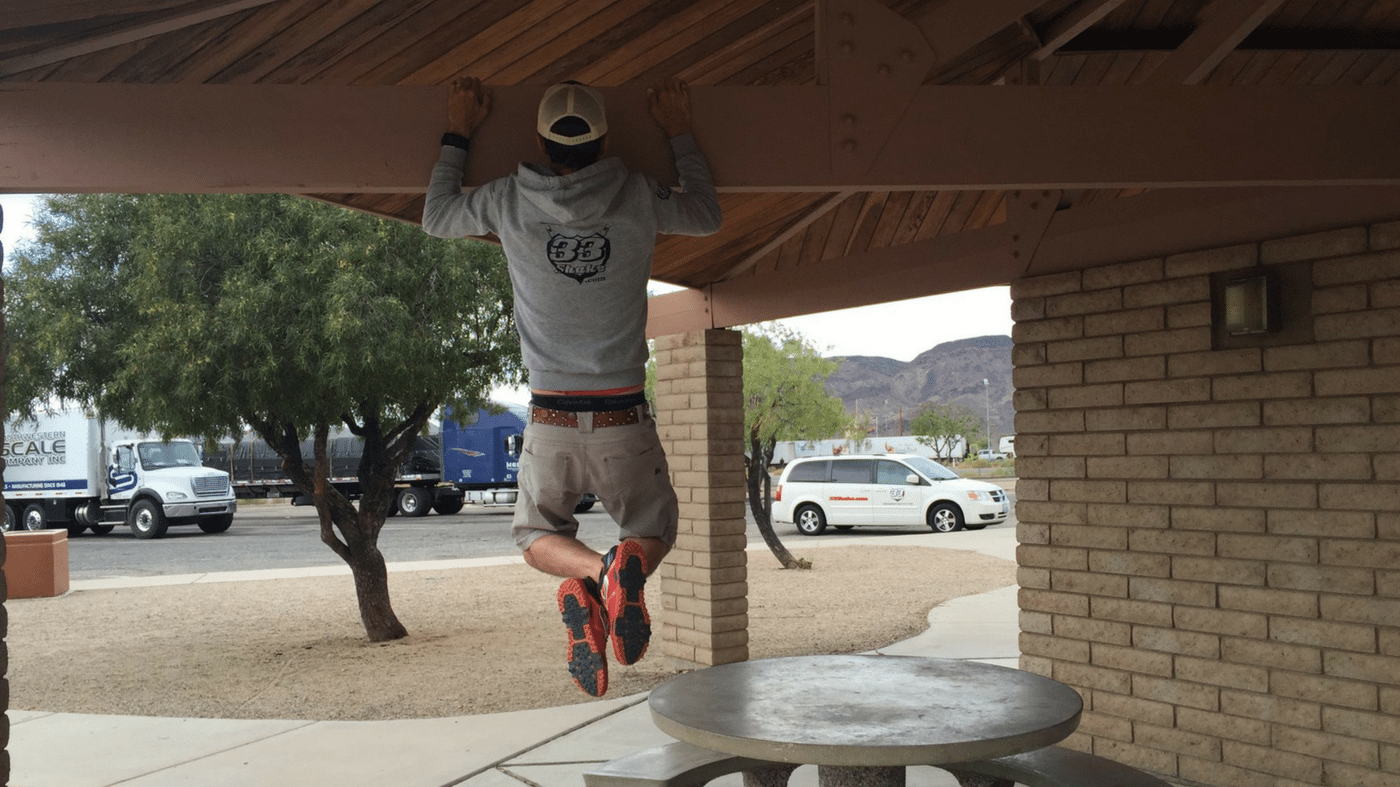September 12, 2016
It is no secret to my friends and family that I personally detest long road trips in the car.
Even when driving through the most pristine of scenery – from great state parks to winding river roads to epic mountain passes – I'd rather be bicycling, hiking, or simply getting to where I'm going as fast as possible on an airplane. Something about sitting in a car just drives me nuts.
But not so for my friend Warren Pole, an ultramarathon runner, co-founder of an endurance nutrition company, and a guy who just completed a 3-month, 11,000-mile, 21-state rollercoaster of back-to-back 16-hour days driving a van across the US.
And while I've discussed in Podcast #308 how I keep grip training devices and lung training devices in my own vehicle and book bag to stay fit even when I'm on a long car ride or airplane trip…
…I've written the article “4 Ways to Burn More Calories on a Road Trip“…
…and I've even snapchatted the 50-50-50 workout my friend Matt and I recently did on a road trip through Montana (that's 50 burpees and 50 kettlebell swings every 50 miles)…
…I've never delved into the nitty-gritty details on how to tackle an extremely long road trip like the one Warren just completed.
So, without further ado, here are Warren's top tips for keeping a road trip from making you fat, sick and unhealthy, and stumbling out of your car with stiff muscles while burping up the nasty bag of trail mix you bought at the last convenience store you passed.
The Problem With Road Trips
Whether you're traveling for business or pleasure, a long road trip can hurl a wrecking ball through your best training and nutrition intentions, leaving them lost in a tangled heap amidst a sea of shifting schedules, alternating timezones, all manner of meetings, and the random delights of eating on the move, at the mercy of every menu but your own.
No doubt about it…life on the road and fitness make for terrible bedfellows.
Or at least that’s the story we tell ourselves, probably because it is a perfect excuse for the missed workouts (“hotel didn’t have a gym”), the Dunkin' Donuts for breakfast and burgers for everything else (“it was all I could find”), as well as the compounded nights of messed up sleep (“everyone wanted to stay out late”).
But a story is just what this is and like any story, it can be changed. You're the author of your own story and, conveniently, you are always everywhere you go. So if you change your traveling story to the one you want, e.g. “I stay fit or get fitter when I travel”, it's suddenly your call. If you pack your virtual wellbeing suitcase with the tools and strategies to do just that, then you can deliver on that new story wherever you are.
For me, as someone who loves fitness (35-plus ultramarathons and counting), eats a primarily plant-based diet, loves healing, ancestral nutrition (the dietary changes I've made in the last 6 years have made me faster, stronger and have eliminated a lifelong dependency on asthma inhalers), and who spends half of every year traveling for work (I co-founded an endurance nutrition company in 2012 that is now open in 25 countries worldwide), I’ve had to learn all this the hard way.
That may be bad news for me, but it's good news for you because all you need to do is read this, pick the tips and tricks you like, and drive into your next road trip safe in the knowledge that you’ll be bringing every ounce of fitness you want back home with you, rather than leaving it behind on the road.
What you're about to read are the exact strategies that I used during my company's US launch tour, which involved a 3-month, 11,000-mile, 21-state rollercoaster of back-to-back 16-hour days.
Not only did I weigh the same at the finish as I did at the start, but I was also equally fit, as confirmed by the tests on my Polar V800 watch, which showed the exact same fitness test score before and after. More importantly I arrived back in my hometown of London able to effortlessly pick up right away with my regular training partners.

One last important point before we dive in…
…this is not about denial or unnecessary self-sacrifice, but rather about carrying the wellbeing mindset and plan you use at home away on the road and sticking to it. So if you’d be happy to have an occasional few beers and night out with friends at home and the same opportunity presents itself on the road, then go for it.
But the key is to stay in the driving seat to maintain the balance you want with both diet and exercise, regardless of where you are.
————————-
Tip #1: Take Your Morning Routine Everywhere
A good morning routine is the stuff of champions, and few world class performers in any field are without one (here is Ben's routine). Your routine should require no brainpower, saving that precious fuel for the day’s meatier tasks.
For myself and my wife (and fellow business co-founder/road-tripper) Erica this means hopping out of bed for 15 minutes of meditation and 20 minutes of yoga before breakfast.
The meditation is a pressure release for the stresses of modern life and building a company, plus it’s a fitness and wellbeing booster. Excess stress means excess cortisol and adrenaline, which both reduce strength and performance, as well as increasing long term risk of serious mental and physical illness.
The yoga takes the sting out of long days at the desk or riding the “planes, trains and automobiles” merry-go-round. It’s also a great daily shot of prehab and rehab for running. Add in the meditative benefits and yoga’s a straight win-win.
To keep this power-packed duo on hand at all times we recommend one app and one website, both of which can be carried on your smartphone.
-The smartphone app Headspace: Headspace meditation is a simply brilliant series of guided meditation that delivers the goods without being too woo-woo weird. It’s perfect if you want to establish a meaningful meditation practice but find the heavy hippy vibe that often accompanies many aids off-putting as we did.
Treat your Headspace meditation like morning training. Lay out clothes the night before to hop into as soon as you wake up so you can just pop your headphones in and get to it without complications. This increases your chances of success tenfold
-The website DoYogaWithMe: DoYogaWithMe is simply the bomb for online yoga courses. You can choose from loads of sessions with great instructors from 10 minutes to an hour-plus, from beginner to intermediate and across every style of yoga imaginable. Most are free, paid options exist too. Don’t know where to start? This Vinyasa Vitality is one of our favorites.
Get used to doing your yoga with no mat – it’s one less thing to carry, particularly when traveling light. 99% of all yoga moves are fine even on pavement, and for the ones that aren’t, a towel or t-shirt under the knee or elbow or hip in question covers it. All you now need for yoga is one smartphone and a pair of shorts.
After the morning routine comes breakfast, which means it’s time to dive into…
————————–
Tip #2: Plan Your Nutrition
Planning is almost everything when it comes to maintaining a dietary sweet spot as you travel. I say “almost” because without the right mindset to fuel it, all the planning in the world is useless. This means you need to have the plan and plan to use it.
Having experimented for years with the diet that works best between us, what is ideal for Erica and I is eating almost entirely plant-based and gluten-free. This is the most challenging diet to maintain on the road in the western world because food on the move here is uniformly built around meat, cheese, mayo, butter and bread.
But whatever your diet desires are, you can rest that assured everything you're about to read has been fully road tested and is guaranteed shockproof – meaning that if these strategies can maintain a plant-based diet under extreme duress across Europe and the USA, they can most likely maintain just about any diet you plan for your next road trip.
We actually dialed in our skills in this arena while crewing endurance beast Luke Tyburski on his “Ultimate Triathlon“, which was a 12-day, 1,250-mile solo triathlon from Morocco to Monaco. Luke fueled exclusively with our products and plant-based real food throughout, while all his crew members ate fully plant-based too. We're not saying that you must eschew meat on your next long road trip, but just want to ensure you're fully informed that we did indeed figure out a way to squeeze in a lot of vegetable-based meals and avoid simply chomping on beef jerky for our entire adventure.
Keeping everyone fed during that series of crazy 20-hour days during the Ultimate Triathlon, with nothing but what we could find in the rare Spanish and French markets we had time to stop at, was indeed one hell of an education.
Not only that, but since then, Erica and I built upon those lessons to stay strong, powerful and energized for our company's USA tour. During our 3 month stint we ate like kings (and queens), didn’t touch a bite of traditional road food, maintained great energy and focus, and did it all for less than a daily junk food budget.
Here’s how…
1. Build A “Nutrition Kit” (for 2-4 people)
Here's what you need for your kit…
-A big plastic crate, with a lid. This is going to become your kitchen, to be whipped out of the car for instant mealtimes anywhere from rest areas and roadsides to motel rooms and kitchenettes. Size is everything. If in doubt buy a bigger crate than you think you need – having everything easily accessible in one place makes all the difference. Also make sure the lid seals. We used 64 liter boxes from Staples.
-Tupperware. Hit Dollar Tree and stock up. Too much is never enough, as lids always disappear mysteriously like socks in the wash. If you really want to follow all Ben's rules about not eating out of plastic, then use Pyrex glass containers instead.
-Kitchen essentials. Cutlery, peeler, tin opener and bottle opener (even self-catering places rarely have these) a sharp knife for chopping, one chopping board, water bottles and plastic plates. Don’t forget the washing up liquid. A large plastic bowl for mixing up salads on the move is also mighty handy and wet wipes are a lifesaver for ‘washing up’ on the move
– A small, powerful blender. We use a NutriBullet, they’re tough, good value and the assorted cups they come with are very handy.
2. Include Food Staples
-Tinned beans and lentils. Go for organic wherever possible, check labels for minimal additives/preservatives, and try to soak when possible using a chart like this. We eat plant-based, but if this were Ben's list, he'd likely recommend tinned or canned sardines, oysters, anchovies instead of legumes.
-Tinned chopped tomatoes. Instant sauce, just add herbs, spice and simmer.
-Tons of fruit and vegetables. Carrots and zucchini rock (especially with hummus), avocados are a must for the good fat and more, while bananas and apples are perfect snacking.
-Rice and/or quinoa, gluten-free corn tortillas. Add beans/canned meat and vegetables when you have a cooker and bingo: instant hot and hearty meal with a rocking nutritional profile. Make loads, then stash in the containers for the next day.
-Seasoning: salt, whole garlic, chilli flakes, Tabasco, extra virgin olive oil, fresh limes (for DIY guacamole, rosemary (for roasted veg), cinnamon. All guarantee super tasty meals every time.
-Apple cider vinegar. Two spoons in a glass of water daily works wonders for alkalizing the body. We use Braggs, which you can find in almost any supermarket.
-Chia seeds, macadamia nuts, almonds, deshelled hemp, oats. All super-easy superfood super-boosts for breakfasts, salads, mains and deserts.
Here are a few sample recipes we use with the food staples above…
-Breakfast: UT’s Raw Breakfast
A staple for the crew during the Ultimate Triathlon (UT), this has remained a firm favorite ever since. Serves 2.
Ingredients
- One avocado
- Two apples or pears
- Handful of almonds
- Raw coconut flakes
- Chia seeds
- Oats
- Cinnamon powder
- Raw cacao nibs (optional)
Method
- Half and skin avocado, dice into small chunks
- Peel and core apples/pears, dice into small chunks
- Add almonds, 1 tbsp coconut flakes, chia, oats and cacao nibs (if using) and blend together in bowl
- Add cinnamon to taste for sweetness
- Divide into two bowls and serve
-Lunch: Insalatona
 In Italian this literally means “big salad” and Erica (who’s Italian) uses it to refer to any huge bowl of chunky raw salad. Serves 2-4.
In Italian this literally means “big salad” and Erica (who’s Italian) uses it to refer to any huge bowl of chunky raw salad. Serves 2-4.
Ingredients
- One bag raw leafy greens
- One avocado
- Carrots, zucchini, cherry tomatoes
- 1-2 tins garbanzos, black beans or lentils
- Almonds (optional)
- Chia seeds, deshelled hemp (optional)
- One clove garlic
- Olive oil, salt, chilli flakes
Method
Wash, peel and dice all veg, add to bowl. Drain beans and add to bowl also. Peel garlic glove, chop finely, add to bowl with olive oil, chilli flakes and salt, all to taste. If using chia, almonds and/or hemp, add to taste also. Mix thoroughly and serve
-Dinner: Chili
Hearty, filling and fast. Needs at least one hotplate and saucepan. Serves 2-4.
Ingredients
- One bag raw spinach
- 1-2 tins garbanzos, black beans or lentils
- 1-2 tins chopped tomatoes
- Zucchini
- Mushrooms
- Two cloves garlic
- One onion
- Olive oil, salt, chilli flakes
- Rice
- Gluten-free tortillas
Method
Chop onion finely, add to saucepan with oil and heat to soften. Peel and chop garlic clove finely, add to heating oil. Add chopped tinned tomatoes, salt, chilli flakes and simmer for 5-10 minutes while rinsing rice and putting on (assuming you have two hotplates/saucepans. If not this can be done after cooking the chilli). Add drained beans to chilli, wash and dice zucchini and mushrooms and add to mix. Simmer for 10 minutes. Add spinach in last five minutes so it can steam down and soak in. Add Tabasco to taste, serve with rice and wraps.
-Sample Snack: Three-Ingredient-Guacamole
So good, so easy. Take one avocado and scoop out contents into a bowl. Add juice from one fresh lime and salt to taste, then mash together with a fork. Serve with chopped vegetables for dipping on its own, or add to salads and chilli wraps.
-Sample Snack: Rice Cakes With Nut Butter
Smoosh nut butter (sugar-free and vegetable-oil free) on a rice cake, then top with sliced banana. This is a perfect sweet treat in a hurry to keep you off the candy bars when the road trip munchies hit.
And finally, here's a big nutrition tip: use AirBNB instead of hotels for acces to better kitchen facilities during your overnight stays. Even hotels with kitchens are rarely well stocked and many only have microwaves or mini ovens for cooking.
Want even more? Check out Ben's podcast episode #234, in which he truly geeks out on healthy foods for camping.
————————-
Tip #3: Be Flexibly Inflexible With Training
With your morning routine having fired you up and a great day’s nutrition ahead, it’s time for some training on the road. The keys, as ironic as it may sound, are both flexibility and inflexibility.
Lets start with inflexibility.
When something matters to you, it goes in the diary and, just as success with key sessions is rooted in scheduling them to fit the demands of your week, so the same is true on the road. Plan ahead and figure out where those important sessions fit into your trip, diary them and don’t deviate.
Just be realistic: scheduling morning sessions during a family holiday with multiple small children may be unwise, as can scheduling late night sessions when you’ve got back-to-back evening engagements. But the gaps will be there, your job is to find them and make them count.
This is a great strategy, but on its own, it’s guaranteed to fail on the road.
Need a gym for specific apparatus? No chance. Cycling and need your bike but you’re traveling hand luggage only? Busted. Swimming and no pool within 100 miles? Whoops.
The list goes on and on, so this is where strategy number two comes in: flexibility. Flexibility means paring down your kit needs to things you will always have with you and being alert to all opportunities.
So all bodyweight workouts are in and running is the best cardiovascular component to add in. Toss in a pair of run shoes, shorts and a shirt and you’re good to go anywhere, even if it is just a trusty out and back hack. A skipping rope is another ideal lightweight addition to the travel bag, as are resistance bands and a tennis ball for trigger point relaxation work, which is perfect to iron the kinks out after a long day’s drive.
Beyond this, allow your imagination to run wild. Here are a few of Erica and I’s favorites to get you started:
-Urban run tourism
This is the best way to see a new city. Grab a map from hotel reception or use your phone and work your way around assorted attractions on the run. It’s super-stimulating being somewhere new and as a runner, and you can enjoy an unparalleled feeling of living like a local while bagging your training fix. Also, explore apps like the UrbanAdventureQuest app to find running and walking adventures in the city you're in.
-Urban gym
As skaters look at a park bench and don’t just see a sitting place, they see a rail slide opportunity, so looking at your urban surroundings with new eyes transforms them into a gym. Combine with run tourism for an awesome session in any city. How? Check out a few of my ideas below (and also consider grabbing this amazing Parkour Strength Training book, perfect for transforming any urban setting into a fantastic gym).
-Park Bench: tricep dips, invert pushups of all varieties, box jumps, step-ups, knee-ups…

-Stairs: sprint repeats, hop repeats (hop up on one leg, run down, hop up on the other leg, repeat), up and down crab crawls and crawls…

-Walls & Trees: inverted pushups of all varieties, wall squat, one-legged wall squats, tree-climbs…
-Scaffolding & Tree Branches: pull-ups, inverted pull-ups, bouldering, hand-walking, muscle-ups…

-Hotel Gym/Pool:
Sounds like a no-brainer but these can often be cramped and poorly stocked as they’re there to add a star to the hotel’s rating rather than actually provide training opportunities.But don’t discount them immediately. Small pool? Lengths are out, but pool running is in. Tiny gym with nothing but a treadmill? Perfect: put it on max incline and run until you fall off, which is a huge bang-for-buck session.
-Tall Hotels & Buildings:
No, we’re not talking about leaping these in one mighty bound Superman style, but instead making use of gravity and the stairs. Running hill repeats up and down a 50-story building is a workout you won’t forget in a hurry and you don’t even need to leave the building. Better still, as everyone uses the elevators in tall buildings, you’ll have the stairs to yourself.
-Freeway Rest Areas:
After a day at the wheel the last thing you need is a rest at the rest area. Instead, it’s the perfect space to get the juices flowing again, so run laps, bust out a 15-minute bodyweight session, or hit some yoga stretches. Or try Ben's famous “50-50-50 workout”: every 50 miles stop for 50 burpees and 50 kettlebell swings (or if no kettlebell is handy, rock overhead presses).

-Cycle Hire
Hopping a city bike in places like Chicago, New York, Paris or London is a great way to turn city travel into daily activity, but it sucks for that long ride fix. The hefty bikes are s-l-o-w and longterm hire will dent your wallet harder than buying a new ride. So for that long ride consider hiring a decent road or mountain bike if you’re in a destination for a few days, as there are no bike box hassles, and you can just carry your kit and ride free. Erica and I rode the Tour de France’s famous Mount Ventoux in France this way and have been sold on the idea ever since
-Strava, RidewithGPS, etc.
There are a huge number of platforms for producing, sharing and downloading run and ride routes that any excuse for not getting it on in a new city is now destroyed. Use these platforms to find routes for your sessions anywhere. Strava is our personal favorite, simply because the interface is so good.
And here's a few final tips:
-Make sure your training clothes are all lightweight and wicking, because that way you can wash them in the hotel sink (shower gel or shampoo are ideal for this), wring them out and have them fresh and dry the next day.
-Get a watch (or an Oura ring) with an activity monitor, set it to the highest level of activity and make sure you hit at least 100% daily. Training should ideally be on top of this, but for monitoring your base level and keeping you honest, having a step count in mind can work wonders.
-Keep in your travel bag, satchel, purse, glove compartment or carry-on Ben's two clandestine ways to train your grip and your lungs, even if you can't move any other muscle in your body: a Captains Of Crush grip training device and a PowerLung.
Summary
A huge thanks to Warren for these road trip fitness and nutrition tips. Have your own tips to add? Leave them in the comments section below.
Finally, if you're curious to learn more about Warren's nutrition company, or to try his product, then check out his website at 33Shake.com.
33Shake is Chia Seed based energy gel (Ironman triathlete Chrissie Wellington is their “spokesperson”) that Warren invented, a gel which relies upon fats and whole foods to fuel the body, rather than sugars, maltodextrin, fructose and harmful central nervous system stimulants. To prepare one of these unique gels, you simply unscrew the spout and inflate the sachet. Then you add water to the neck, reseal and shake. The gel contents, especially the chia seeds, then absorb the water and naturally form an amazing tasting gel that will last for 24 hours.
You can use the code “Ben33” to get 10% off any 33Shake order. Enjoy!
















I remember hearing one of your podcasts Ben, where an Aussie asked you how to keep healthy when your job requires you to stay in a car for long periods of time. You gave some very sound advice but I can’t find the episode where you answered his question. Any idea which one it is? Thanks
great article . add large and small plastic zip lock bag for dirty laundry to keep it from your good clothes ( bathing suits etc. ) , add a HRM + strap to monitor your activity. Ziplock nuts and your favourite bars. zip lock lotions ( sunscreen etc.) – take your GPS / monitor off your bike to track activities. Bill (Canada)
Thanks Ben, great help! My husband and I just became full time RV’ers in June. On our first road trip I ate horribly and didn’t work out much. We take off today and I’ve got the cooler packed with healthy foods and I will definitely use your fitness ideas. Thank you!!!
Great article! Thank you so much. Just wondering about coffee???? I do have a question, though. What do you think about adding a pinch of baking soda in the apple cider vinegar and water? Thanks!
Great boost to alkalinity and the morning bowel movement!
Baking soda + vinegar = grade-school science fair volcano.